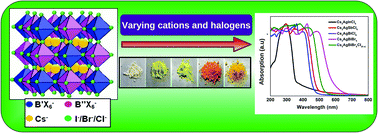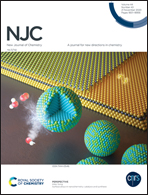Optical tunability of lead free double perovskite Cs2AgInCl6via composition variation
Abstract
Lead free halide double perovskites have emerged as a stable alternative to lead based hybrid perovskites. Double perovskites involving cations like In3+, Sb3+ and Bi3+ are synthesized by varying the metal and halide composition and their optical properties are studied. The possibility of formation of double perovskites in terms of radius ratio, Goldschmidt tolerance factor and octahedral factor are discussed. Br–Cl mixed halide perovskites are synthesized via antisolvent precipitation reactions. XRD, EDAX, XPS and Raman spectroscopy studies confirmed the successful synthesis of the double perovskites, which have shown good stability under ambient conditions for months. Chlorine containing systems have shown better stability. Cs2AgInCl6, a direct bandgap material, has shown the highest stability and with addition of other halides the stability of the perovskites was observed to be decreased. The charge carrier relaxation observed from the photoluminescence (PL) spectra indicated the presence of trap states and disorder in the structures. Bi and Sb based double perovskites are indirect band gap materials, but have shown emission peaks at energy very close to the bandgap energy, which may be related to the pseudo-direct bandgap nature. This study has shown that the band gap and luminescence properties of the double perovskites can be easily tuned by varying halogens and by incorporating disorder in the structures and are suitable for optoelectronic applications.



 Please wait while we load your content...
Please wait while we load your content...